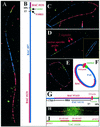Rational design of landmark probes for quantitative DNA fiber mapping (QDFM)
- PMID: 10734207
- PMCID: PMC102834
- DOI: 10.1093/nar/28.8.e30
Rational design of landmark probes for quantitative DNA fiber mapping (QDFM)
Abstract
Rapid construction of high-resolution physical maps requires accurate information about overlap between DNA clones and the size of gaps between clones or clone contigs. We recently developed a procedure termed 'quantitative DNA fiber mapping' (QDFM) to help construct physical maps by measuring the overlap between clones or the physical distance between non-overlapping contigs. QDFM is based on hybridization of non-isotopically labeled probes onto DNA molecules that were bound to a solid support and stretched homogeneously to approximately 2.3 kb/microm. In this paper, we describe the design of probes that bind specifically to the cloning vector of DNA recombinants to facilitate physical mapping. Probes described here delineate the most frequently used cloning vectors such as BACs, P1s, PACs and YACs. As demonstrated in representative hybridizations, vector-specific probes provide valuable information about molecule integrity, insert size and orientation as well as localization of hybridization domains relative to specifically-marked vector sequences.
Figures

References
-
- Weier H.-U.G., Wang,M., Mullikin,J.C., Zhu,Y., Cheng,J.-F., Greulich,K.M., Bensimon,A. and Gray,J.W. (1995) Hum. Mol. Genet., 4, 1903–1910. - PubMed
-
- Cheng J.-F. and Weier,H.-U.G. (1997) In Fox,C.F. and Connor,T.H. (eds), Biotechnology International. Universal Medical Press, San Francisco, pp. 149–157.
-
- Duell T., Nielsen,L.B., Jones,A., Wang,M., Young,S.G. and Weier,H.-U.G. (1998) Cytogenet. Cell Genet., 79, 64–70. - PubMed
-
- Duell T., Wang,M., Wu,J., Kim,U.-J. and Weier,H.-U.G. (1997) Genomics, 45, 479–486. - PubMed
Publication types
MeSH terms
Substances
LinkOut - more resources
Full Text Sources
Research Materials

